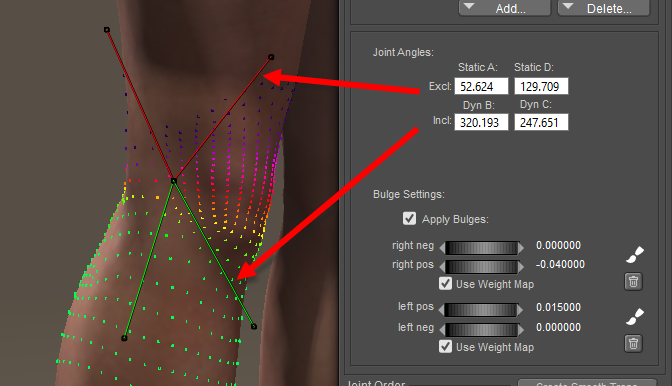Setting Joint Angles
If you move any part of your body (for example bending your elbow), you will note that the skin on your upper and lower arms remains still except for the region near your elbow. Around your elbow, skin stretches or contracts depending on its location and the direction of motion. Slightly removed from the actual motion area, your skin and muscles move to adjust to the motion and preserve a smooth transition. The area between the inclusion and exclusion angles is called the blend zone, where Poser stretches, bends, and shrinks polygons to achieve a smooth transition between figure elements. This is the same as when you flex your leg and the skin in the area of your hip contracts or stretches as needed to accommodate the move.
Poser accomplishes similar movement transitions with inclusion and exclusion angles. The Bend, Side-Side, Front-Back, and Up-Down parameters allow you to define the inclusion and exclusion angles for the selected joint. The Inclusion and Exclusion angles control which polygons move as a result of a joint bending and how the body parts on either side of the joint blend to accommodate the move.
- The inclusion angle defines which polygons are affected by moving the selected joint. Using the previous example of bending your arm at the elbow, your entire arm below your elbow moves. The inclusion angle appears as two green lines that form an angle. In the Joint Editor, the Dynamic B and Dynamic C angles determine the inclusion angle.
- By contrast, the exclusion angle defines those polygons not affected by moving the current joint. Notice that your upper arm does not move if you simply bend your elbow. The exclusion angle appears as two red lines that form an angle. In the Joint Editor, the Static A and Static D values determine the exclusion angle.

Joint inclusion and exclusion angle settings.
The above graphic shows the exclusion angle above the knee, the inclusion angle below, and the blend area in the vicinity of the joint itself. To edit inclusion and exclusion angles:
- Move the cursor to an end point of the inclusion or exclusion angles until the cursor changes to a target symbol.
- Drag the angle. It is recommended that you use Full Tracking mode to view the effects of your changes as you drag. You can also enter your desired values in the text boxes.
You can use the Editing tools to adjust this parameter. This parameter exists in three dimensions, meaning you can rotate the figure to see the joint from any angle. You may, however, want to leave the figure in its default position and use the orthographic cameras (Top, Bottom, Left, Right, Front, Back) to constrain movement to two axes, possibly avoiding much confusion.